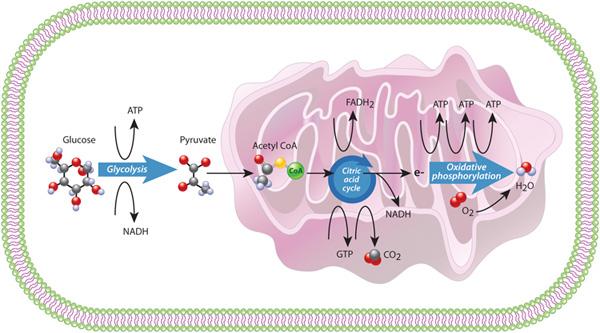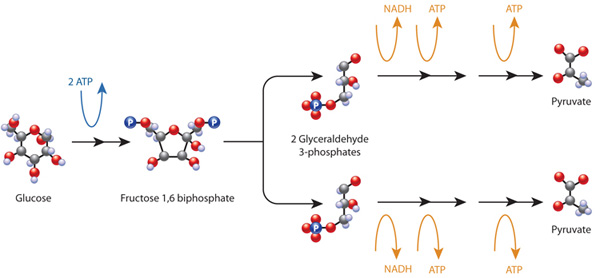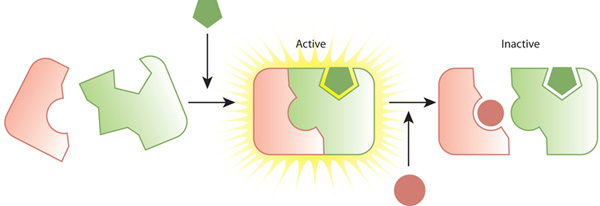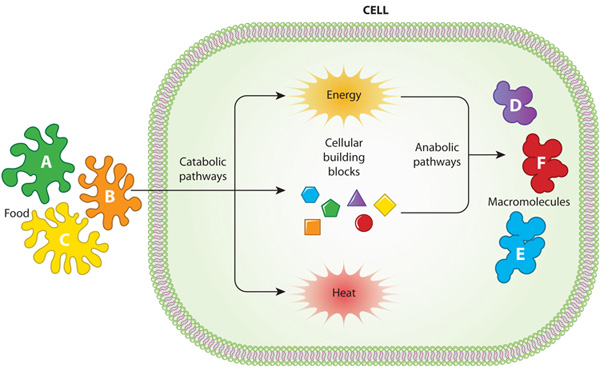Carring Out Metabolic Processes by Which Cells Acquire and Use
This metabolic process occurs in chloroplasts thanks to chlorophyll and it produces sugar along with oxygen. ATP adenosine Triphospate Carries energy in s form the cell can use.

The Back Of The Store Were All The Clothing Is Like The Vacuole Of The Living Cell Vacuole Stores Water Food Enzyme Old Hot Topic Edgy Outfits Cells Project
This process requires more energy than any other metabolic process in the cell.

. Metabolic pathways can be broadly divided into two categories based on their effects. In contrast cellular respiration breaks sugar down into smaller molecules and is a breaking down or catabolic pathway. During photosynthesis plants use energy originally from sunlight to convert carbon dioxide gas CO 2 into sugar molecules like glucose.
Glycolysis is the first step in the breakdown of glucose to extract energy for cellular metabolism. A cell division B protein. Energy from ATP breakdown is used for cellular work.
CeC6H12O6 6O2 6CO2 6H2O energy. Photosynthesis is the primary pathway in which photosynthetic organisms like plants the majority of global synthesis is done by planktonic algae harvest the suns energy and convert it into carbohydrates. Internal combustion engines like the ones found in cars use O 2 through the air intakes to break down gaso-line.
Process that transfers energy from molecules and makes it available for cellular use. Feedback inhibition involves the use of a reaction product to regulate its own further production Figure 411. Some prokaryotes have special enzymes and pathways that let them metabolize nitrogen- or sulfur-containing compounds.
Just as the dollar is used as currency to buy goods cells use molecules of ATP to perform immediate work and power chemical reactions. The transport synthesis and breakdown of nutrients and molecules in a cell require the use of energy. A cell also requires O 2 to break down its fuel see Figure 52.
This reaction is summarized as. Causes cells in muscle adipose tissue and liver to take up glucose from the blood and store it in the liver and muscle as glycogen glycogen synthesis. Living things consume sugar as a major energy source because sugar molecules have a great deal of energy stored within their bonds.
The complete set of. A B C into usable. Catabolic pathways involve the breakdown of nutrient molecules Food.
Thus in the eucaryotic cell the mitochondrion is the center toward which all energy-yielding processes lead whether they begin with sugars fats or proteins. Metabolism includes the breakdown of substances catabolism the formation of new products synthesis or anabolism or the transferring of energy from one substance to another. Life requires energy to exist.
Photosynthesis happens in plant cells some algae and certain bacteria called cyanobacteria. C 6 H 12 O 6. This consists of a two-step process.
-main energy-carrying molecule in the cell. Its effect is the opposite of. Catabolic and anabolic pathways in cell metabolism.
Photosynthesis is the primary pathway in which photosynthetic organisms like plants planktonic algae perform the majority of global photosynthesis harvest the suns energy and convert it into carbohydrates. What are the two types of metabolic reactions. 6CO 2 6H 2 O energy - C 6 H 12 O 6 6O 2.
The process does not use oxygen and is therefore anaerobic processes that use oxygen are called aerobic. ATP is the primary energy currency of all cells. Photosynthesis is the primary pathway in which photosynthetic organisms like plants the majority of global synthesis is done by planktonic algae harvest the suns energy and convert it into carbohydrates.
Plant cells are hypertonic compared to the surrounding soil. Enzymes act as catalysts for metabolic reactions. The metabolism of amino acids occurs predominantly within the liver however the kidney muscles and adipose tissues also carry out amino acid metabolism.
Building off the previous unit where we took a detailed look at the cell cycle here we focus on cells utilize their metabolism to acquire and utilize energy for cellular processes including homeostasis. This is one of the basic tenants of life. Photosynthesis which builds sugars out of smaller molecules is a building up or anabolic pathway.
Carry out essential life functions. Builds large molecules from simple ones. The citric acid cycle also functions as a starting point for important biosynthetic reactions by producing vital carbon-containing intermediates such as oxaloacetate and α-ketoglutarate.
The breakdown of glucose during metabolism is call cellular respiration can be described by the equation. Enzymes are proteins that are specific for particular reactions. The breakdown of glucose a simple sugar is described by the equation.
The by-product of photosynthesis is oxygen which some cells require to carry out cellular respiration. Reactions use chemical energy. Produced by the beta cells of the pancreas.
Prokaryotes play key roles in the cycling of nutrients through ecosystems. Metabolic processes have the following characteristics in common. Living organisms must take in energy via food nutrients or sunlight in order to carry out cellular processes.
This helps to promote water. The by-product of photosynthesis is oxygen required by some cells to carry out cellular respiration. Plays an essential role in carbohydrate and fat metabolism controls blood glucose levels and promotes the uptake of glucose into body cells.
The light-dependent reactions plus the Calvin cycle or light-independent reactions are the main parts of photosynthesis. In a most efficient and elegant way cells have evolved to use the products of their own reactions for feedback inhibition of enzyme activity. It is important for the overall.
Glycolysis takes place in the cytoplasm of both prokaryotic and eukaryotic cells. A transamination step and an oxidative deamination step. Cellular respirationa biological version of internal combustionis the main way that chemical energy is harvested from food and converted.
The by-product of photosynthesis is oxygen required by some cells to carry out cellular respiration. The cell responds to an abundance of the products by slowing down production during anabolic or catabolic reactions. They consume carbon dioxide and produce oxygen as a waste product.
Prokaryotes may perform aerobic oxygen-requiring or anaerobic non-oxygen-based metabolism and some can switch between these modes. The metabolism of sugar a simple carbohydrate is a classic example of the many cellular processes that use and produce energy. Nearly all living organisms carry out glycolysis as part of their metabolism.
Up to 24 cash back Unit 5. Organisms need nutrients in order to A.

Cell Energy Cell Functions Learn Science At Scitable

Cell Metabolism Learn Science At Scitable


Comments
Post a Comment